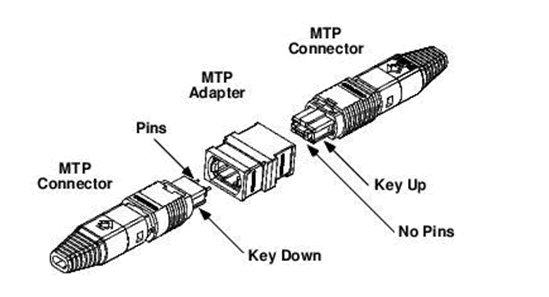Maximizing the Efficiency of Optical Connectors
Major advances in connection techniques have expanded the role of fiber optic cables. It’s becoming easier to connect several fibers in one fell swoop, saving time and money on installations that use fiber.
By David Kiel and David Kozischek, specialists at Corning Optical Communications, and Mike Hughes, project manager at US Conec
Optical Connectors
Seasoned industry professionals may recall the early days of fiber optics, when excruciating, days of painstakingly installing and connecting countless fibers, one at a time, was standard procedure. As the number of data centers grew exponentially, designers and installers were tasked with managing hundreds and even thousands of single- and dual-fiber connector solutions. To accommodate the high volume of connectors within ever-tighter space constraints, installers and designers were forced to create more elaborate storage and routing solutions that came with their own set of challenges.
Fortunately, those days are long gone – thanks in large part to the emergence of the multi-fiber push-on (MPO) connector. The MPO format dramatically reduced the amount of time, effort, and space required to install and deploy network technologies, particularly in parallel optic applications.
Multiple Fibers Mean More Challenges
At the heart of the MPO connector lies mechanical transfer (MT) ferrule technology, originated by a leading Japanese telecom company in the mid-1980s for use in its consumer telephone service. This MT ferrule technology became the basis for the first MPO connector, introduced in the early 1990s.
The timing couldn’t have been better. Networks were being tasked with transmitting more data, more quickly. As the need for bandwidth increased, the industry began moving toward networks and cabling with higher fiber densities – the multilane highway of data transmission.
This heralded the beginning of what is known today as parallel optics, or optical transmission using multiple fibers. Because of the increase in “lanes” used with parallel optics – the number of fibers moving data back and forth – an efficient, high-density interconnect was needed. The MPO connector format succeeded in establishing a compact means to efficiently couple and decouple the high-density MT ferrule format via a bulkhead-mounted coupler. More fibers, however, also meant more installation considerations.
Addressing the Challenge
To remedy the installation challenge presented by ever-increasing quantities of fibers, Corning, an innovator in materials science, joined forces with US Conec, a leading developer of interconnect components. In 1996, the MTP® connector brand — a family of advanced MPO connectors designed for 4-, 8-, and 12-fiber ribbon applications — was released.

MTP Connector Cross-Section
Less Time, Less Space
Before the MTP connector came to market, it typically took two installers a full day to terminate and test 144 fibers. With MTP connectors, suddenly installers had the ability to rapidly connect eight to 12 fibers at a time with the snap of a tool, or using a pre-terminated plug-and-play cable, trimming a daylong job to just a few hours.
Faster deployment was one thing. But installers also needed a way to fit more fibers into smaller spaces. MTP connectors addressed this challenge. Even before parallel optics gained popularity, installers were struggling to provision high-density applications. MTP connectors made it easier to do exactly that.
With the increasing prevalence of plug-and-play solutions, MTP connectors quickly became the format of choice for data centers, offering an alternative to LC and SC connectors. But the MTP format is more than a niche connector, with advantages that translate across a wide range of technologies beyond parallel optics. Since their launch, MTP connectors have undergone continual improvements that make them the ideal multi-fiber connector choice for any data center, of any size.
Highly adaptable and flexible, MTP connectors have continued to evolve to meet the emerging needs of installers, data centers, and the organizations that rely on them.
Lower Insertion Loss
In 1999, US Conec introduced low-insertion-loss MTP Elite® connector components. Corning then built on this technology to provide low-loss, high-density cabling solutions that delivered premier optical performance and reliable signal power.
The earliest versions of the MPO connector format could plug in without problem, but accidental bumps to the cable could result in signal instability. Installers welcomed the introduction of the floating ferrule in the MTP connector. The innovative design allowed the ferrules to stay in contact while the connector housings rotated relative to each other.
Simpler to Make — and Use
In 2002, the MTP’s original thermosetting ferrule technology migrated to polyphenylene sulfide (PPS) thermoplastic injection molding, which is much less susceptible to moisture absorption — a key culprit in degraded connector performance. The adoption of thermoplastic injection molding also made it possible to quickly scale up production to meet high-volume demand, while also improving control over ferrule end-face geometry during the polishing to improve connector performance.
But the MTP brand isn’t built just for the mega-cloud, big data, and hyperscale computing. The latest versions of MTP connectors are designed to work not only with true fiber-to-fiber connections, but with a host of other technology and electronics across all vertical industries — financial, medical, educational, co-location, and more.
With its usefulness in so many different applications and so many different technologies, the MTP connector offers versatility that is definitely an advantage for installers. But this versatility has also presented some challenges. Installers struggle with not knowing whether they need a male or a female end, or with managing polarity.
The latest generation of the MTP connector brings novel features and functionality that simplify field configurability. Don’t have the right male or female end on hand? Not a problem. These new MTP connectors make it easy to change gender and polarity in the field, without requiring a specialized skill set or a connector engineer. Along with optimized field configurability, the connectors also feature environmentally friendly performance enhancements that improve the feel of plugging and unplugging.
Things have come a long way since that initial MT ferrule technology. Today, the challenge we face is hyperscale, big data, and cloud data centers. How do we provision, add, and support high-density, bandwidth-greedy applications that require massive space to accommodate a massive number of cables? With its ever-improving insertion loss, fiber density, ease of installation, and its time-tested stability, the MTP connector is ready to meet those demands.
Recently posted:
[related_posts limit=”10″]






